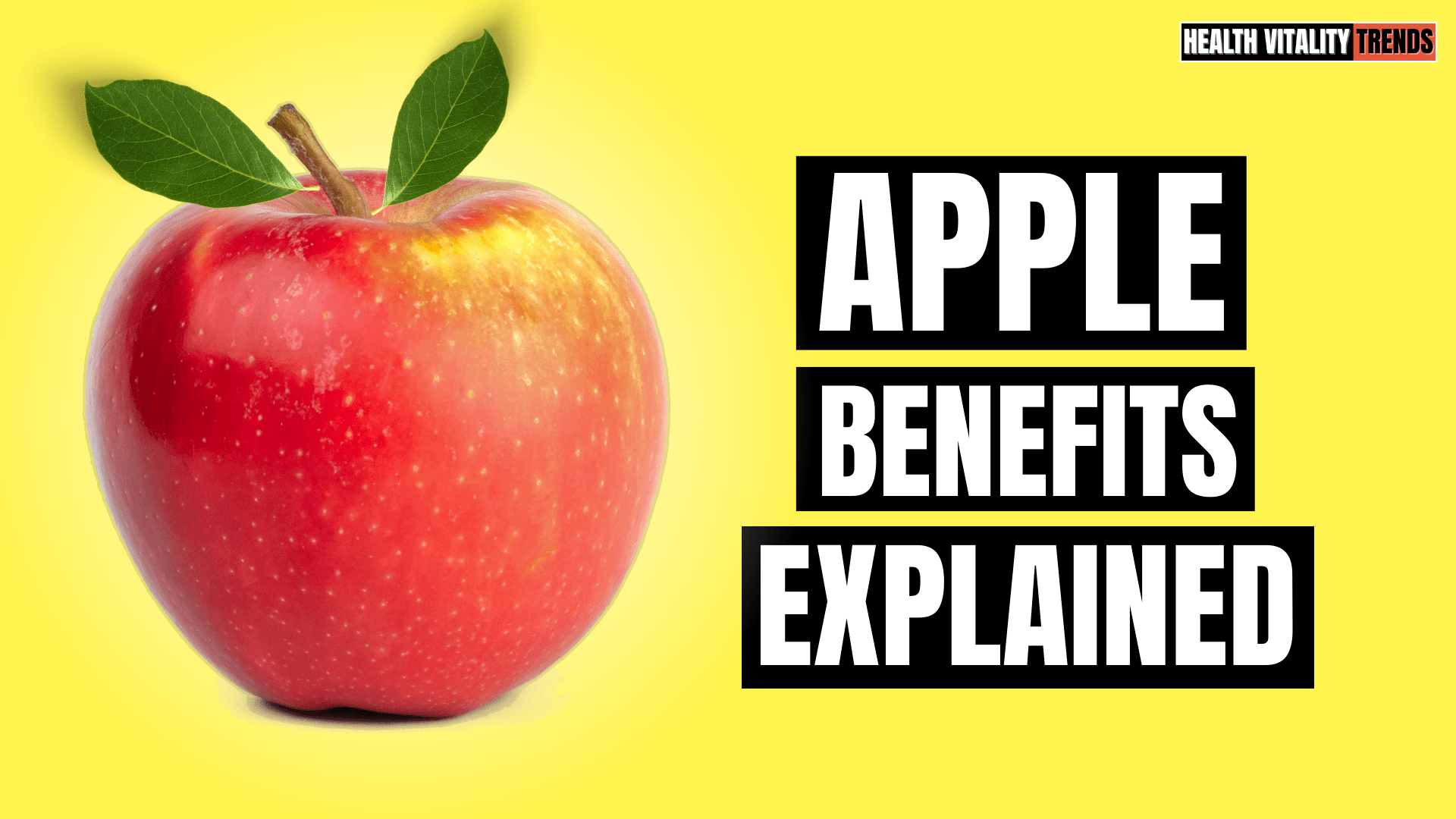
APPLE: The Anti-Inflammatory Superfruit That Supports Gut Health & Blood Sugar Balance
Crisp, juicy, and naturally sweet, apples are among the most popular fruits worldwide—and yes, for good reason. Packed with fiber, antioxidants, and essential vitamins, this everyday fruit supports your overall health while being easy to enjoy on the go.
Whether eaten raw, baked into a dessert, or blended into smoothies, apples offer a delicious balance of taste and nutrition. Let’s explore what makes apples special, their health benefits, and the best ways to enjoy them.
What is Apple?
An apple is a round fruit from the Malus domestica[1] tree, and part of the rose family. Native to Central Asia, apples have been cultivated for thousands of years and are now they are grown across the globe in over 7,500 varieties.
From crisp Granny Smiths to sweet Fujis, apples come in different colors—red, green, and yellow and various sizes, each with a slightly different flavor profile.
Moreover, beyond being just a snack, apples also play an important role in many cultural traditions, such as the famous saying: “An apple a day keeps the doctor away.”

What Does Apple Taste Like?
There are countless breeds of apples that have their own unique flavor. From tart and tangy to sweet and honey-like. Some well-known apples are:
- Granny Smith: Crisp, sour, and perfect for baking.
- Fuji & Gala: Very sweet, great for snacking.
- Honeycrisp: Juicy, with a balance of sweet and tangy.
- Red Delicious: Mild and slightly sweet, often eaten raw.
This versatility makes apples suitable for many things. From pies and sauces to salads and juices.
Also See: BANANA: Nutrition, Benefits and How to Eat It
Apple Nutrition Facts
Here’s the nutritional breakdown of one medium apple (about 182 g) with skin, based on USDA[2] data:
| Nutrient | Amount |
|---|---|
| Calories | 95 kcal |
| Total Carbohydrate | 25 g |
| Dietary Fiber | 4.4 g |
| Sugar | 19 g |
| Protein | 0.5 g |
| Fat | 0.3 g |
| Vitamin C | 8.4 mg (14% DV) |
| Potassium | 195 mg (6% DV) |
| Vitamin K | 4 µg (5% DV) |
| Water Content | ~86% |
Explanation: Apples are naturally low in fat and calories, yet they are high in fiber and water, making them filling and hydrating. Their antioxidants, especially quercetin and polyphenols, contribute to long-term health protection.
Health Benefits of Apple
1. Supports Heart Health – Regular apple consumption is linked with a lower risk of heart disease thanks to soluble fiber (which helps lower cholesterol) and antioxidants like flavonoids (Harvard Health, 2020)[3].
2. Helps Manage Blood Sugar – The fiber slows sugar absorption, preventing spikes in blood glucose. Research suggests apples may lower the risk of type 2 diabetes (PubMed Central, 2022)[4].
3. Boosts Digestive Health – The pectin in apples acts as a prebiotic, nourishing gut-friendly bacteria and supporting digestion.
4. Weight Management Aid – Though apples are low in calories but high in fiber and water, they promote satiety and may reduce overeating.
5. May Reduce Cancer Risk – Polyphenols in apples have been studied for their potential to reduce oxidative stress and lower cancer risks (American Institute for Cancer Research)[5].
6. Supports Brain Health – Antioxidants like quercetin may protect brain cells from oxidative damage and age-related decline.
Also See: How to Eat Avocado for Diabetes?
How to Eat an Apple
Apples can be enjoyed in countless ways:
- Fresh as a snack with or without nut butter.
- Sliced into salads for crunch.
- Baked into pies, crumbles, or chips.
- Blended into smoothies or juiced.
- Cooked into applesauce or chutneys.
Fun Fact: In many cultures, apples are given as a symbol of health and love. Like apple gifting traditions in Europe and Asia during festivals.

How to Store Apples to Keep Them Fresh
- Room Temperature: Keeps fresh for 5–7 days.
- Refrigerator: Extends freshness up to 4–6 weeks.
- Avoid Moisture: Store in a perforated plastic bag or crisper drawer.
- Separate from Other Fruits: Apples release ethylene gas, which can ripen other fruits faster.
Possible Side Effects and Precautions
For most people, apples are a safe and healthy choice. However, a few groups should be mindful.
Side Effects
- Digestive Discomfort – Eating too many apples may cause bloating or gas due to high fiber.
- Blood Sugar Concerns – Though moderate, excessive apple juice intake may cause sugar spikes.
- Allergic Reactions – Rarely, some people who are allergic to birch pollen may experience oral allergy syndrome when eating raw apples.
Precautions
- Dental Care: The fruit’s natural sugars may harm teeth if oral hygiene is poor. Always rinse after eating an apple.
- Diabetics: Best consumed whole (not juiced) to minimize sugar spikes.
- Kidney Issues: People with advanced kidney disease should watch their potassium intake.
- Children: Cut apples into small pieces to prevent choking.
Also See: What Are the Disadvantages of Eating Avocados?
Fruits Similar to Apples
If you love apples, you might also enjoy these similar fruits:
- Pear – Similar in texture and sweetness.
- Quince – Tart and firm, often cooked before eating.
- Asian Pear – Crisp like an apple but juicier.
- Crabapple – Smaller, more tart cousin of apples.
Common FAQs About Apple
Q1: How many apples should I eat a day?
Most people can safely eat 1–2 apples daily as part of a balanced diet.
Q2: Is apple good for weight loss?
Yes. Apples are low-calorie and filling, making them a healthy snack choice for weight management.
Q3: Are apple peels safe to eat?
Absolutely. The peel contains much of the fiber and antioxidants. Wash thoroughly before eating.
Q4: Can diabetics eat apples?
Yes. Whole apples have a low glycemic index and are safe for most people with diabetes in moderation.
Q5: What is the best time to eat an apple?
The best times to eat an apple are in the morning, between meals, or before a meal to aid digestion, boost energy, and promote fullness. Avoid eating apples late at night or before bed.
Conclusion
Apples are more than just a convenient snack—they’re a nutrient-rich fruit with impressive health benefits, from supporting heart health to improving digestion.
Their versatility in taste and culinary use makes them a staple worldwide. Whether you enjoy them raw, baked, or juiced, adding apples to your daily diet is a simple step toward better health.
References
- https://en.wikipedia.org/wiki/Apple
- https://snaped.fns.usda.gov/resources/nutrition-education-materials/seasonal-produce-guide/apples
- https://www.health.harvard.edu/heart-health/fruit-of-the-month-apples
- https://pmc.ncbi.nlm.nih.gov/articles/PMC9223382/#sec5-foods-11-01803
- https://www.aicr.org/resources/blog/those-cancer-fighting-apples/#:~:text=Mya%20Nelson,in%20Apples:%20A%20Healthy%20Temptation.








